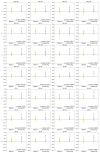Avian Influenza A Viruses Reassort and Diversify Differently in Mallards and Mammals
- PMID: 33808674
- PMCID: PMC8003500
- DOI: 10.3390/v13030509
Avian Influenza A Viruses Reassort and Diversify Differently in Mallards and Mammals
Abstract
Reassortment among co-infecting influenza A viruses (IAVs) is an important source of viral diversity and can facilitate expansion into novel host species. Indeed, reassortment played a key role in the evolution of the last three pandemic IAVs. Observed patterns of reassortment within a coinfected host are likely to be shaped by several factors, including viral load, the extent of viral mixing within the host and the stringency of selection. These factors in turn are expected to vary among the diverse host species that IAV infects. To investigate host differences in IAV reassortment, here we examined reassortment of two distinct avian IAVs within their natural host (mallards) and a mammalian model system (guinea pigs). Animals were co-inoculated with A/wildbird/California/187718-36/2008 (H3N8) and A/mallard/Colorado/P66F1-5/2008 (H4N6) viruses. Longitudinal samples were collected from the cloaca of mallards or the nasal tract of guinea pigs and viral genetic exchange was monitored by genotyping clonal isolates from these samples. Relative to those in guinea pigs, viral populations in mallards showed higher frequencies of reassortant genotypes and were characterized by higher genotype richness and diversity. In line with these observations, analysis of pairwise segment combinations revealed lower linkage disequilibrium in mallards as compared to guinea pigs. No clear longitudinal patterns in richness, diversity or linkage disequilibrium were present in either host. Our results reveal mallards to be a highly permissive host for IAV reassortment and suggest that reduced viral mixing limits avian IAV reassortment in a mammalian host.
Keywords: avian influenza; mallards; mammals; reassortment; viral diversity.
Conflict of interest statement
The authors declare no conflict of interest.
Figures





References
-
- Webster R.G., Hinshaw V.S., Bean W.J., Turner B., Shortridge K.F. Influenza viruses from avian and porcine sources and their possible role in the origin of human pandemic strains. Dev. Boil. Stand. 1977;39:461–468. - PubMed
-
- Wright P.F., Neumann G., Kawaoka Y. Orthomyxoviruses. In: Fields B.N., Knipe D.M., Chanock R.M., Hirsch M.S., Melnick J.L., Monath T.P., Roizman B., editors. Fields Virology. Volume 1. Lippincott-Raven; Pennsylvania, PA, USA: 1996. pp. 1691–1740.
Publication types
MeSH terms
Grants and funding
LinkOut - more resources
Full Text Sources
Other Literature Sources
Medical

